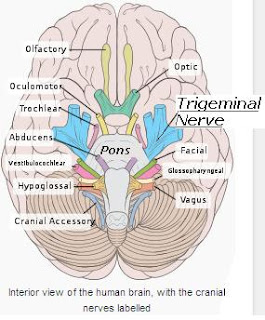The trigeminal nerve, also known as cranial nerve V (CN V), is both a sensory and motor nerve which emerges from the side of the pons, near its upper border, by a large sensory and a small motor root. The sensory fibers of CN V carries sensory information of the head and face, and its motor fibers innervate (contract) the mastication muscles (biting and chewing). The cranial nerve V originates in the trigeminal nuclei located in the brainstem (pons, midbrain, medulla).
The name "trigeminal" means "three-branched", deriving from the fact that this paired nerve, one on each side of the pons, has three major branches: the ophthalmic nerve (CN V1), the maxillary nerve (CN V2), and the mandibular nerve (CN V3). The ophthalmic and maxillary nerves are purely sensory. The mandibular nerve has both sensory and motor functions. The three branches converge on the trigeminal ganglion, that is located within Meckel's cave, and contains the cell bodies of incoming sensory nerve fibers.

No comments:
Post a Comment